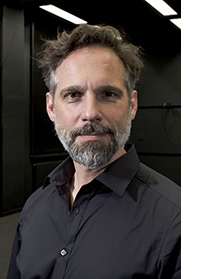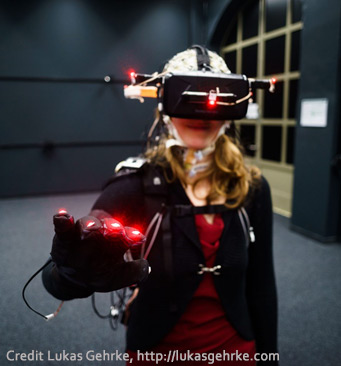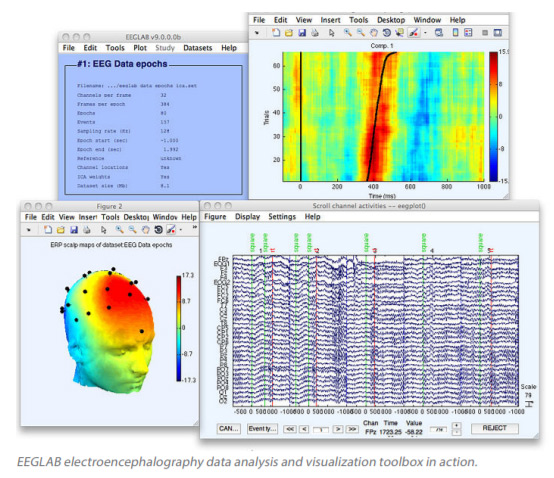 The EEGLAB News #2
The EEGLAB News #2
Klaus Gramann, Ph.D.
Chair Professor, Biological Psychology and Neuroergonomics
Founder of the Berlin Mobile Brain/Body Imaging Lab (BeMoBIL)
Director, Institute of Psychology and Ergonomics at the Technical University (TU) of Berlin
MOBILE BRAIN/BODY IMAGING
“Does lying in an fMRI reflect how our brain works in the natural environment?" asks Dr. Klaus Gramann, Professor of Biological Psychology and Neuroergonomics at the Technical University (TU) of Berlin. He responds, "I have serious doubts.”
Picture yourself lying inside the narrow tube of an fMRI machine. You are asked to perform various mental tasks while remaining completely still inside a machine that buzzes with loud robotic noises. This is how many studies attempt to measure brain activity. Modern brain imaging techniques, like the functional magnetic resonance imaging (fMRI), have contributed substantially to our understanding of the how the brain works (e.g. which areas of the brain are active during different kinds of cognitive tasks). But they do not give us the full picture.
In his TedXTUBerlin talk in 2017, talk in 2017, Dr. Gramann explains that our brain activity changes dramatically when we actively move through space. He describes the brain's calculations when we grasp a glass of water: “First you have to encode the location of the glass with respect to your body. This is based on a coordinate system centered in your eyes, which you have to align with the coordinate system of your hand. Your hand, in turn, is connected to your arm, which is centered in your shoulder, providing yet another coordinate system that has to be aligned with the visual coordinate system to allow control of movement. This is heavy computation! We don’t notice at all. It’s a seemingly simple task for us. But the computational demands underlying that are quite great. And if the glass is moving, the computation load increases.” In other words, changes in active behavior lead to changes in the brain dynamic state.
“So it is my contention,” Dr. Gramann continues, "that if we really want to understand the human brain and how it naturally functions, we have to leave the standard lab setup. We have to measure brain activity in actively behaving humans.” That is why he founded the Berlin Mobile Brain/Body Imaging Lab (BeMoBIL) in 2014. He leads an interdisciplinary team of researchers at Berlin Technical University, using a method of Mobile Brain/Body Imaging (MoBI) he originally helped develop with Drs. Scott Makeig and Tzyy-Ping Jung at the Swartz Center for Computational Neuroscience (SCCN) at UC San Diego in 2007 with Dan Ferris from the University of Michigan who joined the SCCN team for a sabbatical leave from the University of Michigan.
MoBI AND BeMoBIL
Dr. Gramann’s interest in MoBI started as a postdoc at the LMU Munich in 2006, when he first visited SCCN for three months. He was looking for a different means to analyze EEG data in a spatial orienting task, was familiar with Dr. Makeig's work on Independent Component Analysis (ICA) and wanted to learn more.
 “The time with Scott at SCCN changed my perspective on EEG analyses,” Dr. Gramann admits. They started working together on a paper on spatial navigation, and Dr. Gramann was soon asked to join the team. In 2007, they began conducting a series of experiments that investigated participants walking, standing, and running in their environment. This was the birth of the MoBI lab. “We developed Mobile Brain/Body Imaging (MoBI)," he shares, "to overcome restrictions of established brain/body imaging.” They began using 256-channel high-density EEG recordings synchronized to full body motion capture and, later in Berlin, head mounted virtual reality. This allowed them to record and analyze brain dynamics in actively moving participants in real and virtual space. "We did the first MoBI experiment in 2007, followed by many more."
“The time with Scott at SCCN changed my perspective on EEG analyses,” Dr. Gramann admits. They started working together on a paper on spatial navigation, and Dr. Gramann was soon asked to join the team. In 2007, they began conducting a series of experiments that investigated participants walking, standing, and running in their environment. This was the birth of the MoBI lab. “We developed Mobile Brain/Body Imaging (MoBI)," he shares, "to overcome restrictions of established brain/body imaging.” They began using 256-channel high-density EEG recordings synchronized to full body motion capture and, later in Berlin, head mounted virtual reality. This allowed them to record and analyze brain dynamics in actively moving participants in real and virtual space. "We did the first MoBI experiment in 2007, followed by many more."
Before he left SCCN, Dr. Gramann was already eager to establish a MoBI lab in Germany. He and his team created a prototype in 2014 and officially opened the Berlin Mobile Brain/Body Imaging Lab (BeMoBIL) in 2018, before the 3rd international MoBI Conference in Berlin.
Walking into the BeMoBIL lab seems a bit like entering a science fiction movie – participants wear a cap with sensors, a big, black headset and gloves that emit red, glowing lights. But this cutting edge MoBI technology is real. It is made up of a 160-channel EEG that measures the electrical activity of the brain and the neck muscles, synchronized to full body motion capture, and also synchronized to a virtual reality system that allows the team to control visual input. The collected data is then transferred wirelessly to a mobile device.
EEGLAB
 In addition to using MoBI technology, Dr. Gramann uses EEGLAB to analyze his data. He started working with EEGLAB for artifact removal for his studies, but quickly realized the potential of the toolbox beyond artifact removal. He admits, “It was a long and fantastic journey for me to explore the multidimensionality of EEG data.” He continues, “EEGLAB helps in my research as it allows me to dissociate different forms of electrical activities like brain dynamics but also eye movement and muscle activity as coordinated activities underlying natural cognition. Source reconstruction tools based on ICA decomposed data provide additional insights into the neuroanatomical basis of the origin of different activity pattern and thus additional knowledge that helps to explain the measured dynamics. Network toolboxes allow for analyses of the complex interplay of different regions beyond single source time and frequency domain parameters. And an ever-growing community of users contribute to new analyses approaches that can easily be integrated based on the open source toolbox approach.”
In addition to using MoBI technology, Dr. Gramann uses EEGLAB to analyze his data. He started working with EEGLAB for artifact removal for his studies, but quickly realized the potential of the toolbox beyond artifact removal. He admits, “It was a long and fantastic journey for me to explore the multidimensionality of EEG data.” He continues, “EEGLAB helps in my research as it allows me to dissociate different forms of electrical activities like brain dynamics but also eye movement and muscle activity as coordinated activities underlying natural cognition. Source reconstruction tools based on ICA decomposed data provide additional insights into the neuroanatomical basis of the origin of different activity pattern and thus additional knowledge that helps to explain the measured dynamics. Network toolboxes allow for analyses of the complex interplay of different regions beyond single source time and frequency domain parameters. And an ever-growing community of users contribute to new analyses approaches that can easily be integrated based on the open source toolbox approach.”
Over the years, most of Dr. Gramann's analyses has shifted to include use of more MATLAB resources -- currently his group mainly uses EEGLAB for data analysis in combination with other MATLAB toolboxes, and uses the R environment for statistics. “I am supporting further developments of the EEGLAB MoBILAB toolbox and hope to be able to soon support a new head model including eye and neck muscles for a more accurate source reconstruction of MoBI and general EEG data.”
FUTURE DIRECTIONS
“Twenty-five years ago, this MoBI technology wouldn’t have been possible. But now we have two facilities dedicated to Mobile Brain/Body Imaging!,” Dr. Gramann states emphatically. And he envisions an even bigger future: “I hope to see an international network of MoBI labs addressing more and more ecologically valid studies of human cognition. For me personally, I hope to be able to model the human brain dynamics underlying natural spatial navigation answering how the human brain processes visual, vestibular, and proprioceptive information resulting from movement and how this is used to compute complex spatial representations (if something like this exists in the human brain)."
“It is intriguing how action and perception seem inseparable," Professor Gramann concludes, "but only a few researchers have tried to investigate the impact of action on perception and vice versa and how this interplay comes about in the human brain.” He continues, “MoBI allows new insights into one of the central functions of the human brain during more natural interactions with our environment.” The technology allows scientists to ask questions that cannot be addressed with other techniques, thus having potential to provide deeper insights into neurocognitive processes. It appears that MoBI, combined with modes of analysis pioneered in EEGLAB, are opening up a whole new world of scientific discovery.
R. Weistrop (October 2019)
________________________________________________
Dr. Klaus Gramann is head of the chair Biological Psychology and Neuroergonomics at Technische Universität (TU) Berlin. He studied Psychology in Gießen, Germany, Amsterdam, the Netherlands, and in Aachen, Germany where he received his diploma in 1998 in Psychology and subsequently his PhD in Experimental Psychology in 2002 from the Rheinisch-Westfälisch Technische Hochschule Aachen (RWTH). He worked as postdoc at the LMU Munich and at the University of California San Diego. Here, together with Scott Makeig he worked on the development of Mobile Brain/Body Imaging methods to investigate human brain dynamics in actively behaving participants. He worked as visiting Professor at the National Ciao Tung University in Taiwan and the University of Osnabrück in Germany before accepting a position at the Technische Universität Berlin in 2012. He has a keen interest in the neuroscience of embodied cognition with a focus on spatial cognitive processes, visual attention and neuroergonomics. Professor Gramann opened the Berlin Mobile Brain/Body Imaging Lab (BeMoBIL) at TU Berlin in 2014. He has published over 70 research papers since 2005 and has authored several books. His work has received substantial funding and he is a regular reviewer and editor for a number of prestigious journals.